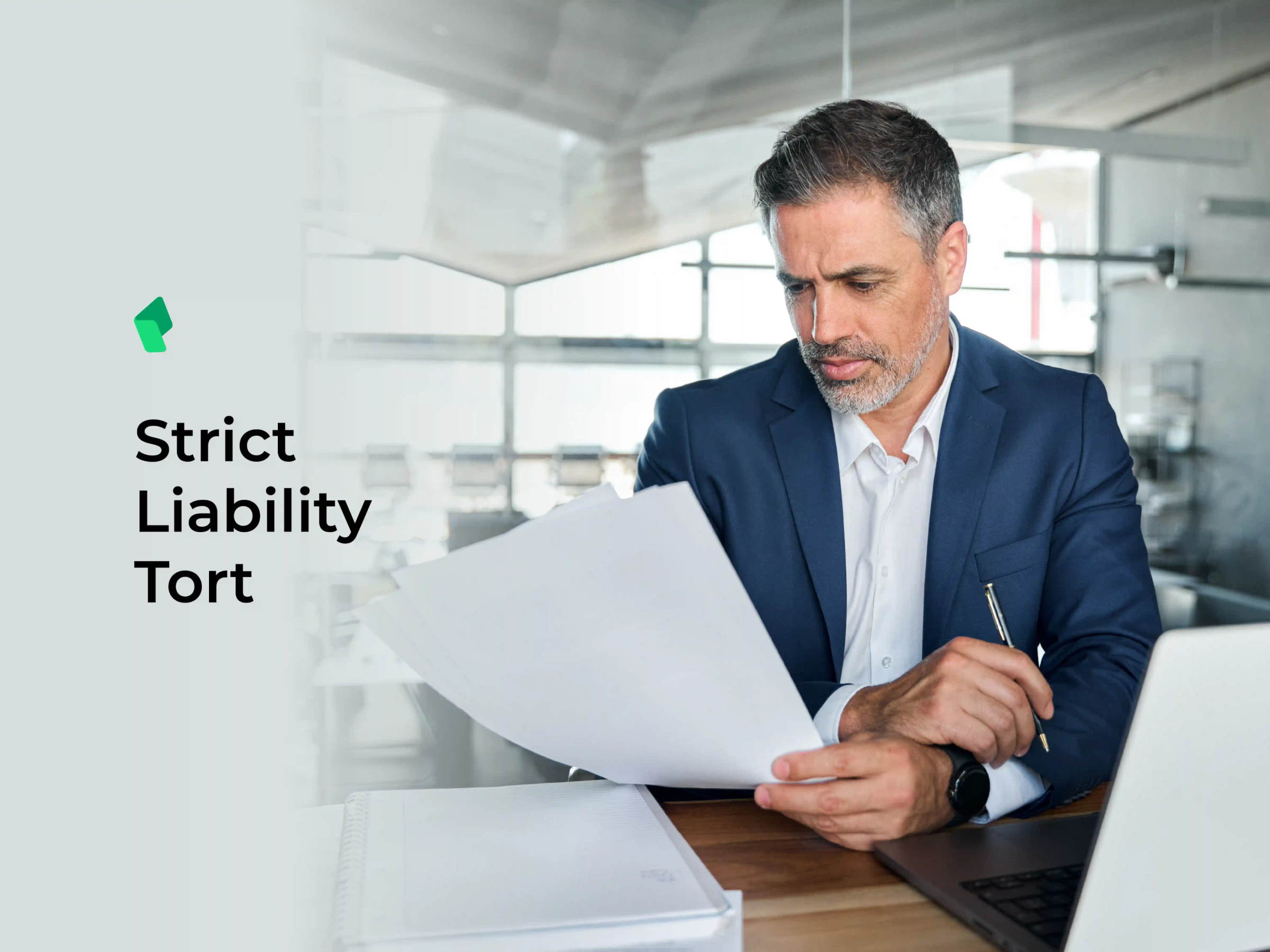Let’s say you purchase a new gadget that malfunctions and causes a serious injury, even though you used it correctly. This scenario perfectly illustrates strict liability tort—a crucial legal doctrine that holds manufacturers, distributors, or sellers accountable for the harm their products cause, regardless of fault or intent.
In this article, we’ll clarify the nature, applications, and consequences of strict liability tort, helping you understand its significance, how it affects individuals, and how lawyers can help them.
What is a Strict Liability Tort?
A strict liability tort is a legal doctrine where a party is held liable for damages caused by their actions or products, irrespective of intent or fault. Unlike negligence, where the injured party must prove a breach of duty, or intentional torts, where intent to cause harm is essential, strict liability focuses solely on the occurrence of damage.
Note: Strict liability (criminal) is a legal doctrine where an individual can be held liable for committing a criminal law offense without the need to prove mens rea.
The concept of strict liability is straightforward: if an inherently dangerous activity or product causes harm, the party responsible is liable, regardless of any precautions taken.
Historical Context
The roots of strict liability can be traced to ancient legal systems, but it became a prominent feature of modern jurisprudence during the Industrial Revolution.
One of the key legal milestones in the establishment of strict liability was the case of Rylands v. Fletcher in 1868. In this case, a reservoir burst and caused extensive damage to neighboring properties. The court held the defendant liable, establishing the precedent that liability could be imposed without proof of negligence.
Rylands v. Fletcher set the foundation for the doctrine of strict liability, shaping its application in various legal contexts.
Core Elements of Strict Liability Tort
Strict liability torts operate under a unique framework in tort law, where fault or negligence does not need to be proven to establish liability. This legal concept is essential in cases where activities or products pose inherent risks, regardless of the precautions taken.
Key Components
Strict liability torts are built on specific elements that must be established for a successful claim.
These include:
Inherent Hazard: The activity or product in question must be inherently dangerous. This means that the activity or product has a high potential for harm even when all possible precautions are taken.
Causation: There must be a direct link between the activity or product and the harm caused. The plaintiff needs to show that the harm resulted from the defendant's activity or product.
Direct Link: The harm must be directly related to the inherently dangerous activity or product. This means there should be no intervening causes that break the chain of causation.
Typical scenarios that involve strict liability include defective products, dangerous activities, and animal attacks. For example, manufacturers can be held liable for defective products that cause injury, even if they were unaware of the defect.
This principle ensures that the risk associated with inherently dangerous activities or products is borne by those who engage in them, rather than the victims.
Establishing Strict Liability Claims
To prove a strict liability tort in court, the plaintiff and the defense must demonstrate several key factors:
Occurrence of Harm: The plaintiff must show that they suffered actual harm or injury.
Direct Link to Defendant's Activity or Product: The plaintiff needs to establish that the defendant's activity or product directly caused the harm. This involves collecting evidence that shows the inherent hazards of the activity or product and linking it to the harm suffered.
Expert Testimony: Often, expert testimony is crucial in establishing this link. Experts can substantiate the inherent risks associated with the activity or product and confirm that these risks directly led to the plaintiff’s harm.
Common Examples of Strict Liabilities (Tort Cases)
Strict liability in tort law holds individuals or entities accountable for damages or injuries caused by their actions or products, irrespective of fault or intention. This legal principle is particularly significant in the following contexts:
Product Liability Claims
Manufacturers and sellers are often held strictly liable for defective products that cause injury. For instance, in the famous case of Greenman v. Yuba Power Products, a defective power tool led to severe injury, and the manufacturer was held liable without the need to prove negligence. This case underscores the principle that manufacturers have a responsibility to ensure their products are safe for consumer use.
Dangerous Activities
Certain activities, such as using explosives or handling toxic substances, inherently carry high risks, triggering strict liability. The Rylands v. Fletcher case is a classic example where the defendant was held liable for damage caused by a reservoir burst, regardless of fault. Similarly, companies involved in hazardous activities like mining or chemical production can be held strictly liable for any resultant harm, emphasizing the need for stringent safety measures.
Animal Ownership
Pet owners can be strictly liable for damages caused by their animals, especially if the animal is known to be dangerous. For example, if a person is bitten by a dog previously identified as aggressive, the owner is held liable for the injuries caused. This aspect of strict liability ensures that pet owners take necessary precautions to prevent their animals from causing harm.
Strict Liability Legal Implications and Defenses
Implications for Plaintiffs
Strict liability offers significant advantages to plaintiffs, notably a simplified burden of proof. Victims can seek compensation without needing to prove the defendant's fault, making it easier to secure justice. This is particularly beneficial in cases involving intricate products or activities where proving negligence would be challenging.
Implications for Defendants
For businesses and individuals, strict liability poses substantial risks. The potential for high damages necessitates robust risk management and compliance strategies to mitigate liability. Companies must ensure that their products and activities adhere to stringent safety standards to avoid potential liability.
Common Defenses
As a lawyer defending a plaintiff in a strict liability claim, you have to anticipate and counter the defenses that the opposition might employ to diminish your client's case.
Here are some common defenses you might encounter and how to address them:
Assumption of Risk: The defense might argue that your client knowingly engaged in a risky activity. To counter this, demonstrate that your client was not adequately informed of the risks or that the risks were not apparent. Emphasize any lack of proper warnings or instructions from the manufacturer. Or if you are representing the company, you should argue that the plaintiff was fully aware of the risks involved and voluntarily accepted them.
Misuse of Product: The opposition might claim that the harm was caused by your client's improper use of the product. In response, show that your client's use of the product was reasonable and foreseeable. Argue that the product should have been designed to prevent such misuse or that adequate instructions and warnings were not provided. Or if you are representing the company, you should argue that the plaintiff used the product in a way that was not intended or foreseeable.
Strict Liability Torts and Personal Injury Law
Strict liability torts are a fundamental aspect of personal injury law, designed to hold defendants accountable for causing harm regardless of intent or negligence. This principle is particularly relevant in cases involving inherently dangerous activities, defective products, or certain animal attacks. Although not all strict liability cases involve personal injury, there is a significant overlap when physical harm results from the defendant's actions or products.
Practical Considerations in Strict Liability Cases
When it comes to strict liability cases there are several practical considerations to keep in mind. These cases often revolve around the inherent danger or defectiveness of a product or activity, making it crucial for plaintiffs and attorneys to understand the specific legal standards and gather robust evidence.
Legal Process Overview
Strict liability cases follow a structured legal process involving several key steps:
Initial Consultation: The plaintiff consults with an attorney to discuss the details of their case. This meeting helps the attorney assess the validity of the strict liability claim, including the nature of the injury and the circumstances under which it occurred.
Filing a Complaint: The attorney files a formal complaint in court, detailing the plaintiff's claims and the legal grounds for strict liability. This document outlines the alleged facts and the basis for holding the defendant strictly liable.
Discovery Phase: During discovery, both parties exchange relevant information and gather evidence. This phase includes depositions (sworn statements from witnesses), interrogatories (written questions), and requests for the production of documents. The goal is to collect comprehensive evidence to support each side's case.
Evidence Collection: Attorneys collect and analyze evidence such as medical records, product documentation, accident reports, and expert testimony. This evidence is crucial for establishing the connection between the defendant's actions or products and the plaintiff's injuries.
Expert Testimony: Expert witnesses may be called to provide specialized knowledge. For example, an engineer might testify about a product's design defects, while a medical expert could discuss the extent and impact of the plaintiff's injuries.
Pre-Trial Motions: Attorneys may file pre-trial motions to resolve specific legal issues. These motions can include requests to dismiss the case, exclude certain evidence, or grant summary judgment (a decision without a trial based on the facts of the case).
Personal Injury Demand Package: Before or during the discovery phase, the plaintiff’s attorney often prepares a personal injury demand package. This package serves as a formal request to the defendant or their insurance company, detailing the plaintiff's injuries, the liability of the defendant, and the compensation sought.
Trial: If the case goes to trial, both sides present their arguments, evidence, and witnesses. The plaintiff's attorney must prove that the defendant's actions or products caused the injury, leveraging the doctrine of strict liability, which does not require proof of negligence.
Verdict and Judgment: The jury or judge delivers a verdict based on the evidence presented. If the defendant is found liable, the court determines the appropriate compensation for the plaintiff, which can include medical expenses, lost wages, and pain and suffering.
Recent Developments and Trends
Recent rulings have significantly impacted strict liability law, especially concerning e-commerce platforms. Notably, in Loomis v. Amazon, the California Court of Appeal held that Amazon could be strictly liable for injuries caused by a defective hoverboard sold on its site by a third party. This decision was based on Amazon's critical role in the transaction, acting as more than just a service provider by facilitating the product's sale).
Similarly, in Pickard v. Amazon.com, the Louisiana Supreme Court ruled that Amazon could be considered a "seller" under state law because it provided logistical support to third-party sellers, thus making it liable for any defects in the products sold.
These cases illustrate a growing trend where courts are holding online platforms accountable under strict liability laws, signaling a shift in liability assessments in digital commerce. This evolution necessitates that platforms like Amazon implement stringent quality controls and oversight to mitigate potential liabilities.
Use CASEpeer to Help with Strict Liability Cases
Strict liability law can be quite complex and to that end cases require meticulous evidence management and client communication. CASEpeer improves legal practice by streamlining evidence collection, managing case details, and tracking deadlines.
Its client communication tools, including secure portals and e-signatures, ensure efficient information exchange. Additionally, CASEpeer’s medical treatment tracking is essential for personal injury cases, documenting injury details linked to a defective product or hazardous activity. Integration with third-party platforms like QuickBooks further supports comprehensive case management.
With CASEpeer, attorneys can handle strict liability cases more effectively, ensuring accountability and protecting clients' rights. So, schedule a demo now and get down to work better and faster.
About the author

Justin Fisher Content Writer
Justin Fisher is a content writer and SEO strategist for leading legal software companies, including MyCase, Docketwise, and CASEpeer. He specializes in writing about emerging legal technology, financial wellness for law firms, and more.
